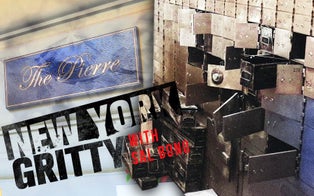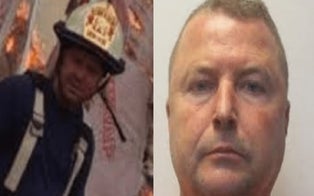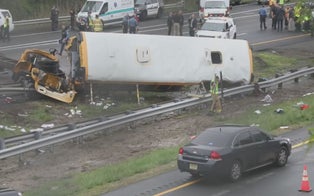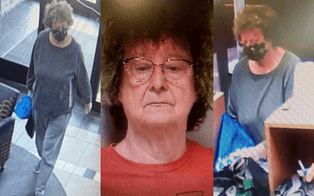In 1998, masked intruders stole $1.6 million from the Bank of America on the 11th floor of the North Tower and almost got away with it.
As employees of various companies and corporations were entering their office jobs at the Twin Towers on a cold morning in January 1998, three masked men waltzed into this hub of commerce and business and walked away with over a million dollars in cash in broad daylight.
Within just 45 minutes the masked intruders stole $1.6 million from the Bank of America on the 11th floor of the North Tower and almost got away with it.
In one of the most brazen heists in New York City history which felt like something out of a Hollywood blockbuster, the caper would lead to a nationwide manhunt and bring down a prominent mafia family.
A Brief History of the Then-Tallest Buildings in New York City
The Twin Towers opened on April 4, 1973, and were the largest buildings in the world at the time. They were citadels of commerce, trade, and power that featured some of the world’s biggest businesses inside as well as fine dining at Windows of the World.
The Twin Towers were part of a seven-building business complex known as the World Trade Center, with the pair of skyscrapers being the largest in the plaza.
The complex contained 13,400,000 square feet of office space and broke ground for building in 1966 and was fully finished by 1975. The estimated cost of the World Trade Center was $400 million, which is nearly $4 billion in today’s money.
Upon opening, the Twin Towers were a marvel of engineering and had the eyes of the world on them — for better or worse — and were a constant hotspot for activity.
Just over a year after being opened, in August 1974, French acrobat Philippe Petit performed a high-wire walk between the North and South towers. He was arrested for his unauthorized stunt but a judge dismissed the charges after Petit agreed to perform a free show for the children of New York City in Central Park.
In February 1975, a fire on the 11th floor of North Tower broke out. No one was injured, but it demonstrated the need for a sprinkler system to be installed into the Twin Towers. The same floor would later be where Bank of America would open a headquarters and get robbed in 1998.
On Feb. 26, 1993, it was the site of a terrorist attack, when 1,500 pounds of explosives went off in the underground parking garage, killing six people and leaving 1,042 others injured. Sheikh Omar Abdel Rahman, also known as “the Blind Sheikh,” and six other individuals were later convicted for their involvement in the bombing.
Kit Roane, a former reporter for The New York Times, tells Inside Edition Digital that the 1993 attack “really kind of shocked everybody.”
Following the terror attack, security was beefed up to as best it could be 30 years ago.
“You had to show an ID to get in,” Roane says. “There weren't metal detectors … but [there was] supposed to be a much more sort of advanced security system that was being put in there. To get onto the elevator, you'd have to swipe it, and that was going to really cut down on things happening. Also in going into parking garages, did stuff like that ... Now that seems kind of amateur hour, but it's very hard to secure a building. You have a hundred-thousand people coming in and out, and that was one of the most secure buildings in the city at the time.”
While security measures were better after the attack, it didn’t necessarily make New York City a safer place.
“I would say that crime seemed to be a worrisome and unending trend and that even The New York Times would lead with it on the front page,” Roane recalls.
Following the terror attack it became almost unfathomable that anyone would try and commit a crime inside the Twin Towers, let alone a massive heist. But one group was brazen enough to do so.
How Masked Men Stole $1.6 Million From the World Trade Center and Led to a Nationwide Manhunt
Around 8 a.m. on Jan. 14, 1998, three masked and armed men entered 1 World Trade Center, which was the North Tower, and left with $1.6 million in cash they stole from the Bank of America.
Authorities said the masked men intercepted Brink's guards delivering cash to the World Trade Center.
“You had three guys who went up an elevator at the 11th floor, which is where there was a Bank of America currency exchange, and they went up there and they waited,” Roane recalls. “Down below, on the street level, you've got two Brink's guards and they're loading up [bags of money], basically about $3.2 million dollars in currency. Half of it is U.S. and half of it is foreign. And they're putting it on a dolly and they're taking it up and I think it's freight elevator five.”
Roane says that when the Brink's guards reached the 11th floor on the freight elevator, the three guys masked men were waiting for them.
“One of them has a gun, pulls the gun, tells them to ‘freeze,’ goes in the elevator, ties them all up, takes three of the bags, rips them open, stuffs the money into their duffle ... they chose the bags that they were getting ... they were very specific about the three, about these three bags,” Roane says.
Roane says that the masked men knew the layout of the North Tower because after they got the bags of money, they sent a freight elevator up to the 22nd floor, which, he says, was under construction and no one was there. Roane says that the crooks casually went down in the passenger elevator to the ground floor, where they took off their ski masks.
“They didn't think about the fact that there were I think 55 cameras in the World Trade Center at that point. And so there were very quickly, images of all their faces that went out on the APB to find them,” he says. “Nobody could figure out how they did it. Everybody said, ‘Oh, it's got to be an inside job'... So everybody thought, this was impossible without someone from the inside helping. And it was the sort of heist.
“It was the sort of story, any story, that was going to lead every paper. It was just made for TV, made for the movies,” he adds. “They almost got away with it except for the fact that their faces were shown, and they went back to their neighborhood.”
Once the thieves’ faces were caught on camera, authorities released their images to the public, and every major news outlet in the city and eventually across the country showcased them in the media.
The crooks were quickly identified as Brooklyn residents Michael Reed, Richard Gillette, and Devlin Folk.
The three men, in their late 30s and early 40s at the time, hailed from the Windsor Terrace neighborhood of Brooklyn, which at the time was a hot bed of mafia activity.
“They're kind of universally disliked in the neighborhood … everybody knows them and everybody knows they're just bad news and they're not going anywhere,” Roane recalls. “So it's all over the newspaper there. There's a Crime Stoppers hotline. Everybody knows that they're going to get $25,000 if they turn these guys in and they go back to their neighborhood, where they're not loved.”
Less than 48 hours after the heist, Folk and Reed were nabbed in their Brooklyn neighborhood, but Gillette was still at large.
Gillette wanted to escape New York City and get away from the heat surrounding the heist, so he boarded an Amtrak train headed to California with a bag of money from the heist, according to reports.
Unbeknownst to Gillette, an all-points bulletin was placed to every law enforcement agency in the country that featured his description, image and what he could be wearing, which included attire of his favorite NFL team — the Green Back Packers.
Steven Devotti and Troy Chadwell were partners with the Albuquerque PD bike patrol and heard about the caper inside the Twin Towers on the news, telling Inside Edition Digital they didn’t think much about it.
That is until it arrived at their doorstep.
While aboard the train, Gillette was questioned by a DEA officer making a standard check because, as Devotti tells Inside Edition Digital, “we have a lot of drugs and money going through” on the trains and into his city.
During Gillette's questioning, he reportedly gave a fake name and had a haggard appearance. He was traveling light and was wearing Green Bay Packers attire.
As the officer continued his rounds on the train, he realized the man he had spoken with was Gillette, thanks to the all-points bulletin. However, as soon as the train made a stop in Albuquerque, Gillette made a mad dash and was off in the city.
Albuquerque police were put on alert that the suspect was in their city.
“When that came out, there was a little bit of excitement, because Steve's like, ‘We're going to get this guy! We're going to get this guy!’” Chadwell recalls.
Chadwell says that because he and Devotti were on bikes and that Albuquerque is not a big city, they believed that it would be easy to catch Gillette.
Gillette attempted to blend in with the crowds in downtown Albuquerque by going into packed bars. One bar he went into, Famous Sam’s, was where he was spotted by the bartender, who called the police.
“The police come in, but by that point, he is not there. And everybody's like, ‘Oh, I don't know where he went. He must have left.’ The police leave,” Roane recalls. “And then turns out he was just in the can. He's the luckiest robber of all. It's just amazing, his luck.”
However, Gillette’s luck would soon run out.
After leaving Famous Sam’s, Gillette headed for a motel, which is where things took a turn, as Devotti and Chadwell went there on a hunch.
Devotti stayed outside as Chadwell entered the motel called The Knights Inn, which would later be made famous in the award-winning shows “Breaking Bad” and “Better Call Saul.” While Chadwell was about to speak to a receptionist, Gillette walked right past him, but he wasn't wearing his Green Bay Packers jacket.
“It doesn't hit me at first because he doesn't have this Green Bay jacket on, and I turn and I don't really recognize [him], it doesn't click in my mind. As I was turning to the clerk behind the desk, I hear Steve yelling, ‘Troy!’” Chadwell remembers. “So I turn around and I go running out, and Steve's got him down on the ground and we got this guy in custody and I had blown right past him.”
The officers drew their weapons on Gillette and say he surrendered without incident. While searching him, the cops found $15,000 cash and, of course, his Green Bay Packers jacket.
“This guy complied with everything. He was really beat. I think he was tired, he was cold, doing a lot of walking. But he wouldn't identify himself, wouldn't provide, he had no idea, wouldn't tell us who he was. He wouldn't talk. But other, I mean, he did it no problem at all,” Devotti says of Gillette during the arrest.
“But it's just like anything in police work, it's right place, right time, and you just do your job and it's just another day,” Chadwell adds.
The two officers’ radio-in that they captured the wayward criminal and, much to their shock, Devotti and Chadwell say it felt like every law enforcement agent in the country quickly descended upon Albuquerque.
After paperwork was complete, Gillette was taken into custody by federal agents and then brought back to New York City.
The Heist That Took Down a Crime Family
The FBI did not believe Gillette, Folk and Reed had acted alone and began to search for accomplices.
Their investigation led them to Ralph Guarino, who authorities say masterminded the plot to rob the Twin Towers.
He was arrested less than 10 days after the robbery at his Staten Island home.
Following his arrest, Guarino agreed to become an FBI informant on the DeCavalcante Crime Family, which the FBI took down in December 1999.
The DeCavalcante Crime Family was based out of Northern New Jersey and was reportedly the inspiration behind “The Sopranos.” The crime family was reportedly known as the “Sixth” family to New York’s infamous “Five Families” of major mafia organizations.
However, the New York Post reported that the "DeCavalcantes were always, by mob standards anyway, minor players in the estimated $50 to $90-billion-a-year industry. In fact, the five families of New York called them ‘the farmers’ and thought of them as country bumpkins.”
However, according to the Post, the DeCavalcantes gained power in the 1990s: As the New York City “families started to break down, the DeCavalcantes took over.”
Following the toppling of the DeCavalcante Crime Family, Gaurino went into witness protection. His records are sealed by the Department of Justice. A source tells Inside Edition Digital he has since passed away.
Gillette, Folk, and Reed were all convicted of their involvement in the heist and served different prison sentences.
Attempts made by Inside Edition Digital to contact the three men behind the heist as well as their attorneys were unsuccessful.
“They were striving to be somebody and being mob-adjacent is not being in the mob. And if you are mob-adjacent, that's your gold ring. So this was the big heist. It was supposed to change their lives forever and I guess it did. Just not in the ways that they had hoped,” Roane says.
Related Stories





